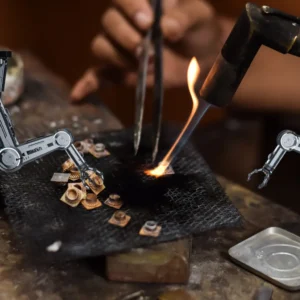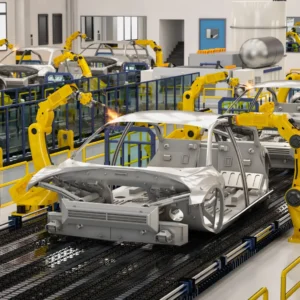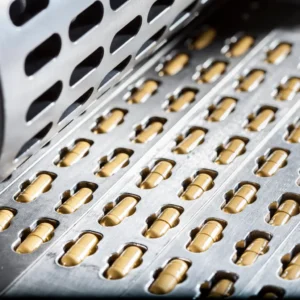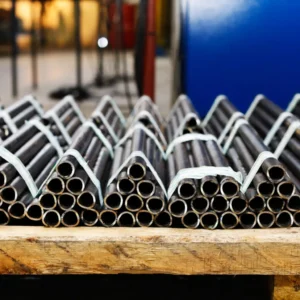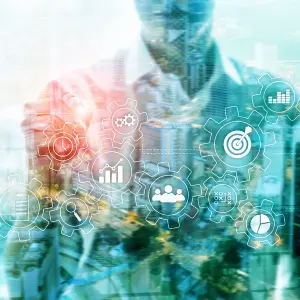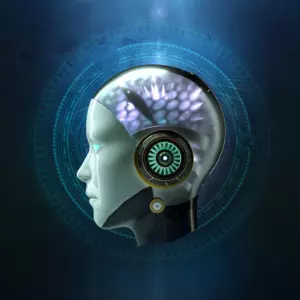
Reshaping Plastics
AI's Revolution in Polymer Production
Welcome to a world where plastics are no longer just materials but a canvas for innovation and sustainability, all thanks to “AI’s Revolution in Polymer Production.”
Join us on an exhilarating expedition through the ever-evolving terrain of the plastics industry. Discover the latest advancements and innovations shaping this dynamic field’s future.
From modern moulding techniques guided by AI to pioneering advancements in eco-friendly plastics, we’ll explore how artificial intelligence reshapes production processes, sourcing materials, and even the skills needed by the workforce.
Join us as we navigate this transformation, meet its pioneers, and envision a future where plastics are efficient, eco-conscious, and adaptable to the world’s changing demands.
Table of Contents
Modern Moulding Techniques with AI
In the realm of plastics, AI’s Revolution in Polymer Production has transformed moulding techniques. Traditionally, this process was driven by trial and error, often leading to inefficiencies. Now, with the integration of AI in plastic moulding, precision reaches new heights. Machines learn from vast datasets, optimizing every aspect of the moulding process.
Machine learning in polymer analysis takes centre stage, enabling real-time adjustments based on material behaviour. Predicting how polymers respond to different conditions empowers manufacturers to achieve unparalleled accuracy. This dynamic approach ensures that every product meets stringent quality standards.
Predictive analytics in extrusion complements this evolution. AI forecasts optimal parameters for extrusion, fine-tuning the process for enhanced efficiency. It’s akin to having a crystal ball, foreseeing the best settings for each unique polymer blend. This not only saves time but also significantly reduces material wastage.
In tandem, AI-optimized supply chains for raw materials revolutionize procurement. Intelligent algorithms analyze market trends and supplier performance, ensuring a seamless flow of high-quality materials. This not only fortifies the production process but also maximizes cost-effectiveness.
As we delve deeper into the future of plastics, one question arises: How are advancements in polymer research aligning with this AI-driven revolution? Let’s embark on the next phase and discover the remarkable synergy between science and technology.
Advancements in Polymer Research
Building on the strides made in Modern moulding techniques with AI, the journey into AI’s Revolution in Polymer Production continues with remarkable advancements in polymer research. As we peer into the ever-expanding horizons of material science, one question beckons: How are these discoveries reshaping the plastic landscape?
Innovations abound as researchers harness the power of machine learning in polymer analysis. AI algorithms scrutinize molecular structures with unprecedented precision. What once seemed complex is now decoded effortlessly, offering insights into creating more robust, lighter, and versatile polymers. These breakthroughs lay the foundation for next-gen plastics.
Furthermore, Efficient extrusion processes are no longer a distant dream. We can now fine-tune extrusion parameters to craft plastics with tailored properties thanks to AI. The question becomes: How does this customization impact industries relying on specific plastic characteristics, such as aerospace or healthcare?
Moreover, sustainability remains at the forefront of polymer research. Scientists are making significant strides in the quest for eco-friendly plastics, exploring biodegradable alternatives and recycling methods. The pressing question here is: Can these innovations transform the plastic industry into a beacon of green manufacturing?
With each discovery, the Advancements in Polymer Research draw us closer to a future where plastics are essential but also sustainable, efficient, and adaptable. But how are these innovations influencing the global push for more sustainable plastic production through Automation? Let’s explore the world of Automation of plastic output to find answers.
Efficient Extrusion Processes
Continuing our exploration of AI’s Revolution in Polymer Production, we delve into Efficient extrusion processes. As we’ve witnessed, polymer research is unveiling remarkable possibilities, but how does this translate into the practical world of plastic manufacturing?
Machine learning in polymer analysis has enabled precise calibration of every extruded plastic to meet specific standards. AI-driven systems monitor and adjust extrusion parameters in real-time, ensuring consistent product quality. But how does this newfound precision impact industries dependent on high-volume extrusion?
Furthermore, the marriage of AI and extrusion goes beyond mere consistency. Predictive analytics in extrusion predicts potential issues before they occur, minimizing downtime and optimizing resource utilization. This begs the question: Can this predictive prowess revolutionize industries that rely on continuous plastic production, like packaging or construction?
Efficient extrusion processes are not just about quality and predictability; they also embrace sustainability. With AI’s guidance, manufacturers can reduce material waste, energy consumption, and emissions. This raises a vital query: How does this sustainability initiative align with AI in sustainable plastics research and the broader mission of eco-friendly plastic production?
As we journey through the unfolding landscape of plastics, the spotlight turns to another critical aspect: Raw material sourcing through AI. How does artificial intelligence revolutionize how we acquire the plastic industry’s essential building blocks? Let’s uncover the answers in our next chapter.
Raw Material Sourcing through AI
In our journey through AI’s Revolution in Polymer Production, we’ve seen how advancements in polymer research and efficient extrusion processes have reshaped the plastic industry. But a crucial question remains: How are we securing the essential raw materials for this revolution?
AI’s role extends to the very foundation of plastic production: Raw material sourcing through AI. It all starts with data-driven insights that guide procurement decisions. Intelligent algorithms analyze market trends, supplier performance, and weather patterns, ensuring a seamless flow of high-quality materials. But how does this impact the stability and cost-efficiency of the plastics supply chain?
AI not only optimizes the selection of raw materials but also enhances inventory management. With real-time data, manufacturers can anticipate demand fluctuations and stock accordingly. The question arises: How does this agile approach safeguard against disruptions in the volatile world of raw material supply?
Moreover, sustainability remains a driving force. AI’s ability to track the environmental impact of raw materials offers a path to greener manufacturing. But how does this align with the broader mission of green manufacturing for plastics and the call for eco-conscious production practices?
As we explore the potential of AI in plastics, we are investigating Automation in plastic production. How do intelligent systems further streamline the manufacturing process, and what does this mean for the industry’s future? Let’s embark on this next stage of our journey.
Automation in Plastic Production
As we’ve witnessed the transformative power of AI’s Revolution in Polymer Production, we now venture into the domain of Automation in plastic production, building upon our exploration of Raw material sourcing through AI. How does Automation redefine the very core of plastic manufacturing?
Automation seamlessly integrates with AI-driven processes, creating a symphony of precision and efficiency. Robots and intelligent machines take centre stage in plastic assembly, operating with unwavering accuracy. But what implications does this have for the workforce adaptation to AI in plastics?
This revolution extends beyond the factory floor. AI orchestrates the entire production process, optimizing resource allocation and minimizing waste. The question arises: How does this level of control revolutionize the plastic industry’s commitment to green manufacturing for plastics?
Furthermore, the automation wave is reshaping the plastics landscape by redefining the role of human workers. It’s not about replacing jobs; it’s about upskilling the workforce to collaborate seamlessly with intelligent systems. How are companies preparing their teams for this new era of plastic production?
It’s time we acknowledge the impact of plastics on our environment and take action towards eco-friendly alternatives. What groundbreaking discoveries await us in the realm of Breakthroughs in eco-friendly plastics, and how will they align with the ongoing automation revolution? Let’s embark on this eco-conscious journey.
Breakthroughs in Eco-friendly Plastics
Our exploration of AI’s Revolution in Polymer Production has brought us to the forefront of innovation: Breakthroughs in eco-friendly plastics. Building upon the foundation of Automation, we now journey into a world where sustainability meets polymer science. How are these innovations paving the way for a greener future?
Researchers and manufacturers are tirelessly working to develop plastics that serve their purpose and embrace environmental responsibility. These eco-friendly plastics, often bio-based or biodegradable, challenge the conventional notion of plastic’s ecological impact. How can these novel materials reshape the mission of Promoting sustainability in plastic manufacturing?
Moreover, AI plays a crucial role in this eco-revolution. Machine learning algorithms assist in the development of sustainable materials by predicting their behaviour and performance in various applications. But how do these predictions translate into real-world benefits for industries striving for greener practices?
One key aspect is recyclability. AI helps identify and design plastics that are easier to recycle and reintegrate into the production cycle. As we explore the capabilities of AI-driven eco-friendly plastics, we must ask: How can these innovations contribute to the broader goal of reducing plastic waste and pollution?
In this era of environmental consciousness, the quest for sustainable plastics is no longer an option; it’s a necessity. But how do we ensure these breakthroughs in eco-friendly plastics become integral to the plastic manufacturing landscape? Let’s delve deeper into the strategies for Promoting sustainability in plastic manufacturing.
Promoting Sustainability in Plastic Manufacturing
In the wake of remarkable Breakthroughs in eco-friendly plastics, the focus now shifts towards Promoting sustainability in plastic manufacturing. How can the industry ensure widespread adoption and promote responsible production with eco-conscious materials rising?
AI’s role here is pivotal. It not only facilitates the development of sustainable plastics but also optimizes manufacturing processes to reduce energy consumption and emissions. How can these AI-driven sustainability efforts be scaled to meet the global demand for greener plastics?
One avenue is collaboration between industry players and regulators. Setting robust sustainability standards and incentivizing compliance can be a game-changer. But how can these standards balance innovation and environmental responsibility?
Moreover, consumers’ choices play a significant role in promoting sustainability. As eco-friendly plastics become accessible, informed consumer decisions can accelerate their adoption. But how do we educate consumers about the benefits and importance of choosing sustainable plastics?
In addition, the Green Manufacturing for Plastics movement encompasses materials and production practices. Manufacturers are reevaluating their processes to minimize waste, recycle materials, and operate sustainably. How can these practices be further encouraged and integrated into the industry?
As we delve into sustainable plastic manufacturing, the focus shifts to nurturing the next generation of professionals in the field. How are educational institutions and industries working together to Train the next-gen plastics workforce? Let’s embark on this educational journey.
Training the Next-Gen Plastics Workforce
Amid the push for Promoting sustainability in plastic manufacturing, preparing the next generation of professionals becomes paramount. How are educational institutions and industries aligning to equip the workforce with the skills to navigate the changing landscape of AI’s Revolution in Polymer Production?
The demand for a skilled workforce surges as the industry adopts sustainable practices and integrates AI-driven technologies. But how do we bridge the gap between traditional plastic manufacturing and the innovations ushered in by Automation, sustainable materials, and AI?
Educational programs are evolving to meet this demand. Universities and vocational schools are introducing courses incorporating sustainability principles, AI applications, and green manufacturing practices. But are these programs keeping pace with the rapidly changing industry?
Apprenticeships and industry partnerships play a crucial role in hands-on training. These initiatives expose students to real-world challenges and cutting-edge technologies. Yet, are there enough opportunities for aspiring professionals to gain practical experience in the evolving field of plastics?
Moreover, fostering a mindset of continuous learning is essential. The plastics industry is dynamic, with new technologies and materials continually emerging. How do we ensure that the next-gen workforce remains adaptable and stays ahead of industry advancements?
As we prepare the next generation of professionals in the plastics industry, we are intrigued by the pioneers who have already made strides in AI-driven plastics. What innovations have they achieved, and how have they influenced the industry’s evolving landscape? Let’s embark on this journey of discovery.
Pioneers in AI-driven Plastics
As we contemplate the role of education in shaping the future of plastic manufacturing, our gaze turns to the trailblazers, the Pioneers in AI-driven plastics. How have these visionary individuals and companies harnessed AI’s potential to reshape AI’s Revolution in Polymer Production?
Innovation often springs from individuals who see possibilities where others see challenges. Pioneering scientists and engineers are at the forefront of AI’s integration into plastics. What inspired them to embark on this journey, and what groundbreaking solutions have they brought to the industry?
Some companies have boldly embraced AI to optimize their plastic production processes. These pioneers set new efficiency standards, from predictive maintenance to intelligent quality control. How have these trailblazing companies transformed their operations, and what results have they achieved?
Collaboration between these pioneers and educational institutions is crucial. How are they actively contributing to the education and training of the next-gen plastics workforce? What initiatives have they undertaken to bridge the gap between academia and industry?
Furthermore, how do these pioneers envision the future of plastics manufacturing? What challenges lie ahead, and how are they prepared to navigate the ever-evolving landscape of AI’s Revolution in Polymer Production?
As we delve into the stories of these pioneers, we are reminded of the ever-changing nature of the plastics industry. What shifts and transformations await us in the dynamic and changing landscape of plastics? Let’s continue our journey to explore the next chapter.
The Evolving Landscape of Plastics
From the pioneers of AI-driven plastics, we transition into the ever-shifting terrain of The evolving landscape of plastics. Their innovation has set the stage for a remarkable transformation in AI’s Revolution in Polymer Production, but what lies on the horizon?
This evolution isn’t linear; it’s a dynamic interplay of technology, sustainability, and market demands. As AI continues to advance, how will it further optimize plastic production? What new applications and efficiencies will emerge?
Sustainability remains a driving force, with increasing pressure to reduce plastic waste and carbon footprints. How will the plastics industry adapt to these eco-conscious demands? What groundbreaking sustainable materials and practices will emerge?
The workforce, too, will evolve as new generations bring fresh perspectives and adaptability to the industry. How will the training initiatives and collaborations with pioneers shape next-generation plastics professionals?
Moreover, consumer choices will influence the landscape. How will consumer preferences impact the industry in a world where eco-friendly plastics are readily available? What role will public awareness and policy play in shaping the future?
As we navigate this dynamic terrain, one question lingers: How will the plastics industry continue to innovate, adapt, and thrive in the ever-evolving landscape of AI’s Revolution in Polymer Production?
Conclusion
In conclusion, AI’s Revolution in Polymer Production has remarkably transformed the plastics industry, and our journey through this evolution has been nothing short of inspiring.
Starting with Modern moulding techniques with AI, we witnessed precision and efficiency reaching new heights while Advancements in polymer research opened the door to more robust, eco-friendly plastics.
Machine learning and predictive analytics optimize extrusion processes to minimize waste and increase efficiency in high-volume industries.
Raw material sourcing through AI revolutionized procurement, ensuring a steady supply of quality materials while posing questions about balancing innovation with environmental responsibility.
Automation in plastic production, the next step in the journey, harnessed the power of AI, redefining processes and the workforce’s role, prompting us to ask how to prepare the next-gen plastics professionals.
Breakthroughs in eco-friendly plastics showed us a future where plastics and sustainability go hand in hand, highlighting the need to educate consumers about responsible choices and sustainable practices.
The quest for Promoting sustainability in plastic manufacturing called for robust standards, collaboration, and industry-wide adoption of green practices, ensuring a sustainable future.
We then met the Pioneers in AI-driven plastics, whose innovation and collaboration with educational institutions promised a brighter future for the industry, sparking questions about the industry’s future challenges.
Finally, we explored The evolving landscape of plastics, anticipating a dynamic future shaped by AI advancements, sustainability, workforce evolution, consumer choices, and policy changes.
As we reflect on this journey, the plastics industry stands at a crossroads of innovation and responsibility. How will it continue to adapt and thrive in the ever-evolving landscape of AI’s Revolution in Polymer Production? The answer lies in those who dare to pioneer, educate, and embrace change, ensuring that the future of plastics is efficient, sustainable, innovative, and filled with possibilities.
Related Articles
- AI in Paper Manufacturing: Pulp and Processors
- AI in Agri-Equipment Manufacturing: Fields and Functions
- AI in Footwear Manufacturing: Steps Ahead
- AI in Jewellery Manufacturing: Gems and Generative Models
- AI in Glass Manufacturing: Crystal Clear Computing
- AI in Construction Material Manufacturing: Bricks and Bytes
- AI in Chemical Manufacturing: Molecular Models
- AI’s Role in Electronic Manufacturing: Circuitry and Systems
- AI in Furniture Manufacturing: Crafted by Code
- AI in Ceramic Production: Fired by Future
- AI in Food Manufacturing: Savory Systems
- AI in Metal Fabrication: Moulded by Machines
- AI in Aerospace Manufacturing: Beyond the Atmosphere
- AI’s Integration in Pharmaceutical Manufacturing: Pills and Processes
- AI in the Automotive Industry: Driving Production
- Weaving AI into Textile Manufacturing: Threads and Tech
- IPA in Manufacturing Sector: How AI Tools Revolutionize Efficiency, Productivity, and Quality

Arindam Roy
An Automation Consultant with 25+ years of IT Experience
Forbes Articles related to AI usage in the Manufacturing Sector:


